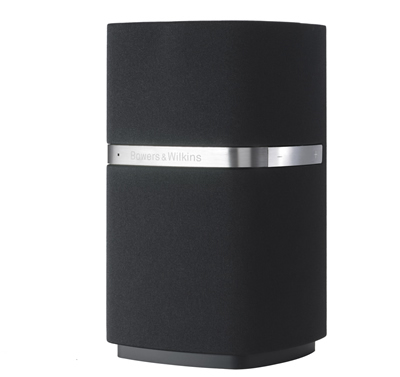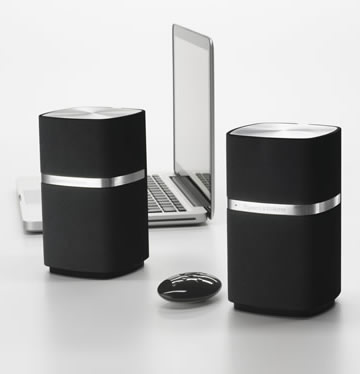|

Bowers and Wilkins Computer Speakers RockBy Jim Bray Computer speakers aren't the sexiest things in the world of audio, but they can sure increase your enjoyment of games, streaming media, computer-based music files, and the like. They're also a dime a dozen, from a dizzying variety of brands, and there are some really good ones that can rival what you can get from a home theater. A small home theater anyway. Into this crowded fray steps Bowers and Wilkins, also known as B&W, a company famous for high end audio speakers such as the Nautilus and the Diamond series. Why would a legendary speaker maker "slum" in the world of diminutive speakers for computers? Well, it could have something to do with enhancing the bottom line, of course, or perhaps it's part of a mission to create speakers better than what the world has seen so far. Whatever the reason, B&W's MM-1 speakers are very nice indeed, handsome in their own right, with a "spun aluminium" plate on top and aluminium accents breaking up the classy-looking black grilles that might otherwise make the speakers look like black bricks than Hi-Fi equipment. They also offer excellent sound for your desktop, wherever your desktop may be. B&W refers to the MM-1's as "true hi-fi speakers, shrunk to fit on your desktop" and that's not a bad analogy. I've been using them in my office for a couple of months now, a place I also use as an audio studio and I think they're great. The sound is so clean and lifelike that even on streaming talk radio stations I can tell the difference between a very compressed signal from a cleaner one. Sometimes it's so clean that it almost sounds as if I'm in the studio with them. As I write this heading into the U.S. midterm elections, I've also noticed the speakers reveal the differences between speakers on some political commercials when the voices were recorded at different times and in different locations. One ad I listened to recently, for example, suddenly went all "hollow-sounding" when one particular voice came on. And that's just with talk radio. Where the MM-1's excel, not surprisingly, is with music, despite their relatively small size and lack of a separate subwoofer. Of course, for five hundred bucks, they should! The MM-1 uses a conventional "master/slave" computer speaker design, in which all the electronics, connections and controls are housed in a master unit (in this case, the right channel). The right speaker also drives the left channel "slave" speaker. A true active loudspeaker, the MM-1 also uses a dedicated amplifier for each individual driver, of which there are two built into each cabinet. One's a three inch job that handles the bass and midrange frequencies; the other takes care of the high frequency stuff. Bowers and Wilkins says they've brought some of their most pioneering technology to the MM-1's, including tweeters that incorporate the "tube-loaded design" they developed for the mighty Nautilus. That's a pretty good place to start. The specifications for the MM-1's states that they use "digital amps", which means they're using "Class D" amps of a type similar to what companies such as Rotel and Bang & Olufsen use to such great effect. They allow for big sound from small, efficient packages and I'm a firm believer in the technology. B&W says the four amps each cranks out 18 watts, which doesn't seem like a lot but which is certainly enough to fill my office space with sound. I wouldn't want to use them in my home theater, but they really rock on my desk. To optimize the audio quality, Bowers and Wilkins used Digital Signal Processing to adjust the sound balance depending on the input signal. B&W says it helps keeps the bass powerful and music rich and detailed at any volume. I have no idea if it's DSP or what, but the end result gets no argument from me: the MM-1's sound great.
I like them best facing directly toward the back wall of my office, as opposed to angled toward me; they seem to have a wider sound stage and better stereo separation in that way, at least in my office. The MM-1's connect to your computer via USB, as opposed to the analog sound card output that some speakers use. The theory behind is that the computer streams the audio to the MM-1's in digital form, at which point the speakers convert it to analog themselves, instead of sending analog signals to the speakers. This supposedly is meant to ensure optimal audio regardless of the quality of the computer's sound card. They've even included a headphone jack that lets you listen privately, the sound enhanced by the digital-to-analog converters in the MM-1's instead of being limited to the often crummy headphone outputs on the computer. Of course this also depends on the quality of the headphones you're using. I tried it with B&W's great P5 "Mobile Hi-Fi" phones and it sounded great. This could be really nice if you're in a hotel room and want to listen to your tunes fairly loudly without disturbing the rabble huddled miserably in rooms around you. The downside, of course, is that you have to pack the MM-1's with you. That isn't something I want to do, but the option's there. A nice touch is Bowers and Wilkins' little, pebble-like remote control, which seems identical to the one I tried when reviewing their Zeppelin Mini iPod speaker dock. It isn't something you'll need to use all the time if you're merely exploiting the speakers on your desktop but, since you can hook the MM-1's into your notebook, iPod or even a CD or DVD player (thanks to its extra audio input) and use it from across the room, it could come in really handy You can also use it to control your iTunes or Windows Media Player. Another thoughtful touch is that the speaker bases are cut away to accommodate and/or store the wiring. In my listening tests, the MM-1's may not have displayed the kind of gut thumping bass you can get with a dedicated subwoofer, but it's surprisingly satisfying anyway, with very good bass that's also smooth and realistic. The higher frequencies sound great and the combination rewards the listener with excellent fidelity that's easy to listen to for long periods of time without becoming fatiguing. I listened to a variety of musical styles, from Sinatra to show tunes, from classical to rock music and the MM-1's didn't seem to have any preference, reproducing all of it very nicely. They can't make a silk purse out of a sow's ear, of course, so if you have music files that sound lousy to begin with you aren't suddenly going to find that all is sweetness and delight, but they will make them sound as good as they're likely to get. Put a great, lossless signal into them and you'll be rewarded handsomely, with transparent audio in which the speakers seemingly disappear – exactly what you want. The MM-1 also has updateable firmware to ensure it's always compatible with the computer's operating systems as well as, the company says, in case they discover a bug in the field. Updating will require the user to download and install a programmer from the B&W website. You can spend a lot less on computer speakers than the MM-1 system requires but, having used it consistently for a couple of months, I don't look forward to going back to my old speakers. The MM-1's are quite simply the best I've heard to date. Copyright 2010 Jim Bray
Jim Bray's columns are available through the TechnoFile Syndicate. We welcome your comments! |
|
|||

 Bowers and Wilkins also claims to have made "electronic adjustments" to help ensure the sweet spot – the place at which the sound is best – is optimized to be a few feet from the computer screen, where you will undoubtedly be sitting while using them. Again, it seems to work in my office, though of course it could depend somewhat on your individual setup. I daresay most people who put the speakers on each side of their monitor at about the same plane as it will be happy.
Bowers and Wilkins also claims to have made "electronic adjustments" to help ensure the sweet spot – the place at which the sound is best – is optimized to be a few feet from the computer screen, where you will undoubtedly be sitting while using them. Again, it seems to work in my office, though of course it could depend somewhat on your individual setup. I daresay most people who put the speakers on each side of their monitor at about the same plane as it will be happy. 